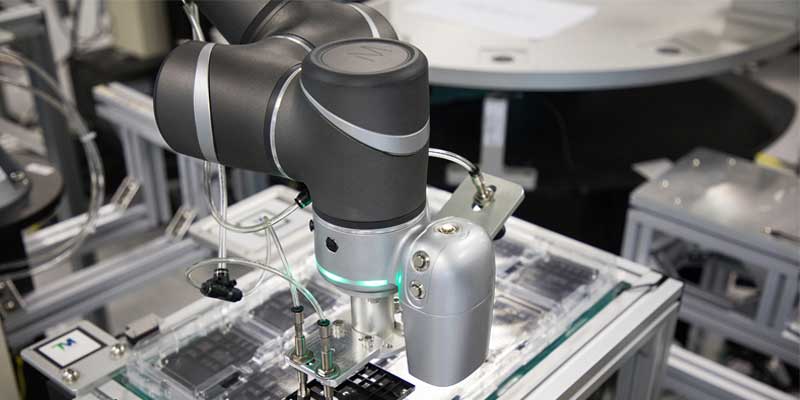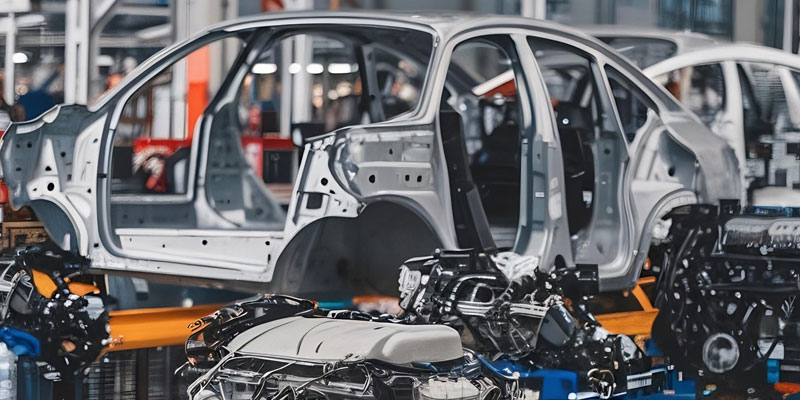Schedule a Call Back
Is cobot market heading for a second growth surge?
 Articles
Articles- May 30,23

The market for collaborative robots (Cobots) is forecast to show strong growth over the coming years, with rising sales in industrial and non-industrial sectors and new application scenarios being developed.
According to Interact Analysis’ newly published ‘Global Collaborative Robot Market – 2023’ report, market revenue grew by 17.2 per cent to $ 954 million in 2022, with shipments increasing by 21.9 per cent to 37,780 units. Following a rapid rebound in 2021 in the wake of the Covid-19 pandemic, the growth rate of the collaborative robot (cobot) market dropped to around 20 per cent. Can collaborative robots return to the previous high-speed growth rate of over 30 per cent within the next 5 years? Where does the growth point for a second surge in shipments come from?
We will analyse the potential for rapid growth in the Cobot market from five perspectives: market, product, industry, application and customer.
Market: Outlook still optimistic
The compound annual growth rate (CAGR) of global collaborative robot market shipments is anticipated to be 27 per cent over the next five years, with China recording a market CAGR of about 30 per cent, and the South America and Southeast Asia regions both exceeding 30 per cent growth annually. As shown in the Graph 1, the growth rate forecast for the next few years is higher compared with 2022 predictions (gray dashed line).
Unlike the price rebound of traditional industrial robots in 2022, the price of collaborative robots is still declining, but the magnitude of decline is slowing down. The main reasons behind this are:
According to our predictions, the trend of price declines for collaborative robots will be relatively shallow in the next 5 years. The increase in the proportion of >10 kg models combining with the added value of in-machine vision with AI solutions have offset a significant decline in average market prices. As a result, we predict annual price declines will remain at 3-5 per cent.
Product: Greater intelligence, payload and openness
Technologies and solutions related to greater intelligence – including artificial intelligence and machine vision – are increasingly being promoted by collaborative robot manufacturers and are gradually beginning to influence customers’ purchasing decisions. Collaborative robot vendors want to further expand their application scenarios and are looking at ways to increase the perceptive abilities and flexibility of their machines.
Demand is growing to expand collaborative robot product lines to carry greater payload, partly from the needs of real applications like palletizing or welding, and also in order to find incremental market growth space. Faced with inevitable competition from SCARA and high-speed small six-axis robots in the small payload sector, many cobot vendors have begun to take advantage of easy deployment, lightweight body, and high cost-effectiveness to develop models with >10 kg payload. Graph 2 presents the payload and arm length of newly launched Cobot models from 2022 to 2023, with the growing trend for higher payload and longer arm length clearly visible.
Greater openness includes different levels of openness in software and hardware. Currently, most mainstream collaborative robot manufacturers provide RDK for system integrators or customers to conduct secondary development. The growing trend towards greater openness will make a more comprehensive range of collaborative robots possible, while also enabling customised solutions to be created more effectively.
Industry: Growth predicted for non-industrial cobot shipments
The global macroeconomic downturn in 2022 struck a significant blow to the non-industrial sector, with the penetration of collaborative robots in industries such as catering, massage, and retail (which are oriented towards individual end consumers) slowing down significantly. The impact of delays to warehousing logistics projects has also resulted in a slower growth rate than expected.
In contrast, as a result of the Covid-19 pandemic, the manufacturing industry has been plagued by work stoppages and labor shortages over the past three years. The demand for upgrading and renovating production lines in traditional manufacturing industries, such as automobiles, metals and general industries, has significantly increased. Coupled with the relocation of factories or production lines by many multinational enterprises in response to supply chain adjustments, and the current trend for reshoring, demand for collaborative robots has significantly increased.
The industry with the fastest growth rate in 2022 was the new energy industry (including lithium-ion battery, wind power, PV and hydrogen), followed by automotive and electronics. This is mainly due to the accelerated growth in various parts of the new energy vehicle supply chain in 2022. Cobots can quickly replace workstations due to their flexibility and ease-of-use.
In addition, collaborative robots have also seen relatively stable growth in industries such food & beverage, and chemicals & pharmaceuticals.
Application: Welding and palletizing emerging fast
According to the Industrial Robots report from Interact Analysis, welding and material handling are the two largest applications for industrial robots. In 2022, over half of all global sales of industrial robots came from these two major applications, with the lion’s share coming from heavily loaded articulated robots. In contrast, the proportion of welding industrial robot sales was less than 5 per cent in 2022, but with huge growth potential.
The poor consistency of manual welding and the harsh working environment make welding a key factor in the overall efficiency of a production line, and it is also the most difficult area for many factories to recruit workers. In small factories, flexible and easily deployable collaborative robots can be used to weld small workpieces, while on large assembly lines welding of complex workpieces can also be completed by combining multiple collaborative robots or using a combination of cobots and skilled workers. Due to the high growth potential of welding scenarios, we have seen major collaborative robot companies, including UR, AUBO, and JAKA, launch specific solutions for welding applications in 2022.
Collaborative palletizing has also become a hot topic, with a significant increase in the application of simple palletizing for collaborative robot arms, and a rise in loads exceeding 10kg in industries such as food & beverage and pharmaceuticals last year.
Customers: Collaboration with customers growing
The collaborative robots sales channel can be divided into direct sales and distribution network (through distributors or system integrators). Because most clients are small and medium-sized companies, the distribution network contributed more than 90 per cent of total market sales before 2020. Direct sales mainly target major customers in key industries, but due to the wide coverage and geographical distribution of the robot market, relying solely on direct sales does not best meet user needs. Distributors are usually systems integrators with engineering backgrounds who provide automation solutions paired with robots for customers in different industries.
The distribution model can quickly build a sales network to occupy the market. However, it’s also important that robot manufacturers do not become overly reliant on the sales and technical support capabilities of distributors, and make sure they have a solid understanding of the actual needs of downstream customers. In order to have a deeper connection with customers and understand their practical application needs, the proportion of direct sales has rapidly increased over recent years, and it has become an important trend for robot manufacturers to collaborate with customers, creating different scenarios and use cases.
Direct sales enable robot manufacturers to provide suitable solutions based on the specific needs of customers, discover suitable applications for collaborative robots in a certain scenario, and work with customers to think about how best to use collaborative robots. By working closely with customers, robot manufacturers can also enhance retention rates and loyalty.
For different application scenarios, there are more suitable semi-customised products or secondary development activities that can be carried out. These methods include:
1. Providing process packages that support rapid deployment and adaptation to certain application scenarios. Users can choose and configure kits according to their needs in order to build their own systems.
2. Providing diversified solutions for secondary development interfaces, which can quickly meet the customized needs of different industries.
3. Launch different semi-customized products for various categories of application.
The future looks bright for the expanding cobot market
Across all the various lenses through which the worldwide collaborative robots market has been analysed, it is clear there are signs of change and growth. We predict the market will continue to expand and adapt in response to shifting customer needs and global events.
Strong growth is predicted in shipments through to 2027 and beyond, with price declines slowing as cobots become more intelligent and capable of carrying greater payload. While logistics applications are currently leading the market, growth is also expected in non-industrial sectors and in areas such as welding, where the full market potential has not been exploited.
In order to make the most of the potential for growth, cobot manufacturers will need to listen closely to what their customers demand and develop new application scenarios, while also working alongside distributors to build their sales networks.
About the author:
Maya Xiao is the lead analyst for Interact Analysis’ Li-ion battery and forklift research, and she also covers markets for industrial and collaborative robots (Cobots). She has an interdisciplinary technical background in vehicle electrification, system automation and robotics.
Related Stories

HANNOVER MESSE to Host Industry Leaders on Future Tech 2025
At HANNOVER MESSE, global leaders from Siemens, Rheinmetall, Accenture and others will share insights on AI, automation, security and industrial transformation shaping the future of industry. update..
Read more
IMTEX Forming 2026: Charting the Next Chapter of India’s Metal Forming Ecosystem
IMTEX Forming 2026, Asia’s largest metal forming and manufacturing technology exhibition, is set to return to Bengaluru from 21–25 January 2026.
Read more
For the foreseeable future, multiple fuels will coexist and grow: Farrokh Cooper
In this conversation with Rakesh Rao, Farrokh Cooper, CMD, Cooper Corporation, shares his views on manufacturing, technology and the road ahead.
Read moreRelated Products

Fanless Industrial Pc for Smart Manufacturing
CONTEC Launches BX-M4600 Series - Fanless Industrial PC for Smart Manufacturing.















